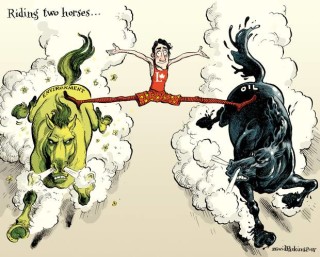This article is a condensed and edited summary of a discussion held with Mark Jacobson, a Stanford University professor who outlined a plan in 2009 for the world to get all of its energy from renewable sources by 2050.
Appropriate Subject Area(s):
Environmental studies, world issues, politics, technologies
Key Questions to Explore:
- What would have to be done to achieve this goal?
- What technologies are currently available?
- Is this doable?
New Terminology:
Cryogenic hydrogen, carbon footprint, politically tractable
Materials Needed:
- Copies of the article for the students
Introduction to lesson and task:
Much attention is being paid to the challenge of climate change. With the conclusion of the recent Paris conference and the heralding of what many are calling a game-changing agreement, there is a renewed optimism that finally the world is taking action on climate change. Also drawing attention are the events surrounding the continual decline in the price of crude oil and speculation as to how low the price will fall. Events such as these have highlighted the interest in renewable energy and the efforts which are being made to develop and refine methodologies to capitalize on these resources. But how likely are we to achieve these lofty goals? Are they, in fact, realistic? There are many who question our will to make the necessary changes or our ability to develop these resources in a sustainable fashion. Mark Jacobson argues that these are certainly attainable goals and that the necessary technologies are available and possible. Using the truncated summary of his interview as supporting material, this lesson will have the students consider the likelihood of attaining a world in which all energy will come from renewable sources by 2050 and the challenges and problems that would have to be overcome in order to do so.
Action (lesson plan and task):
- Begin the lesson by reading the first three lines of the article, “In 2009,…solar resources by 2050”, to the class.
- Without discussing the quote in any detail, assign the students to groups of five or six and ask them to discuss and prepare a response for the class to the following questions:
- Do you feel that this is possible to achieve? Why?
- What challenges and obstacles must be met in order to achieve a world which relies solely on renewable energy by 2050?
- Allow the groups time to discuss and prepare their reports.
Consolidation of Learning:
- Once this has been done, have each group, in turn, present their report and respond to any questions or comments from the class.
- Once all groups have reported, provide the students with a copy of the article and allow them time to read it.
Success Criteria:
The students will:
- Be able to identify challenges and obstacles that have to be overcome in order to attain a world which is totally reliant on renewable energy.
- Be able to offer an informed opinion on whether or not it is likely that the world has both the ability and commitment to attain this goal by 2050.
Confirming Activity:
- Once the students have read the article, conduct a plenary session during which they can offer their reactions to what they have just read and indicate their belief as to whether or not the world has the mettle necessary to accomplish this goal.

